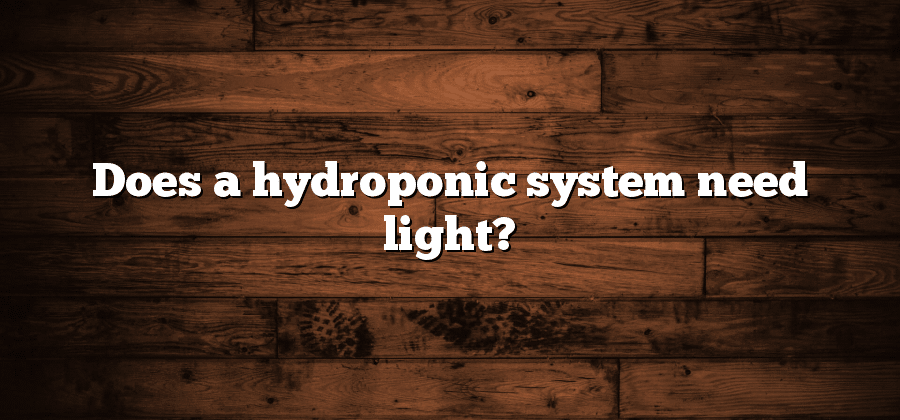Role of Light in Plant Growth
Light is a vital factor in the growth and development of plants. It plays a critical role in photosynthesis, the process by which plants convert light energy into chemical energy to fuel their growth. Through photosynthesis, plants produce glucose, the building block for carbohydrates, which is essential for their overall growth and development. Light is also responsible for stimulating plant hormone production and regulating various physiological processes, such as seed germination and flowering. Furthermore, light intensity, duration, and quality are crucial determinants of plant growth, influencing factors such as photosynthetic rate, leaf expansion, and plant morphology.
Different types of light have distinct effects on plant growth, particularly in hydroponic systems. Incandescent and fluorescent lights are commonly used in indoor gardening, providing the necessary light spectrum for photosynthesis. However, more advanced options such as LED grow lights are gaining popularity due to their energy efficiency and ability to emit specific light wavelengths that are optimal for plant growth. Red and blue light wavelengths, for example, are crucial for promoting vegetative growth and flowering, respectively. By manipulating the light spectrum, hydroponic growers can tailor their lighting systems to meet the specific needs of different plant species and growth stages, enhancing overall crop yield and quality.
Different Types of Light for Hydroponic Systems
There are several types of light that can be used in hydroponic systems to promote plant growth. One of the most commonly used types is fluorescent lighting. Fluorescent lights come in various sizes and can provide a good amount of light for plants, especially when used in combination with reflectors to maximize light distribution. They are also energy-efficient and relatively inexpensive, making them a popular choice among hydroponic growers.
Another type of light commonly used in hydroponic systems is high-intensity discharge (HID) lighting. This includes metal halide (MH) and high-pressure sodium (HPS) lights. MH lights emit a bluish-white light that is ideal for the vegetative growth stage of plants, while HPS lights emit a yellow-red light that is better suited for the flowering stage. HID lighting systems are more costly than fluorescent lights initially, but they provide a higher output of light and can cover a larger area, making them a suitable choice for commercial hydroponic operations.
In addition to fluorescent and HID lights, Light Emitting Diode (LED) lights have gained popularity in recent years. LED lights are known for their energy efficiency, longevity, and ability to emit specific wavelengths of light. This allows growers to tailor the light spectrum to the specific needs of their plants, promoting optimal growth and development. While LED lights may be more expensive upfront, their long lifespan and energy-saving capabilities can offset the initial costs over time.
In summary, the choice of lighting for hydroponic systems depends on the specific needs of the plants and the goals of the grower. Fluorescent lights are affordable and energy-efficient, while HID lights provide higher light output and coverage. LED lights offer customization and long-term benefits. By selecting the right type of lighting, hydroponic growers can ensure that their plants receive the optimal light spectrum for healthy and productive growth.
Understanding Photosynthesis in Hydroponics
Photosynthesis is a fundamental process that plays a crucial role in the growth and development of plants. In hydroponics, where plants are grown without soil using nutrient-rich water solutions, understanding the intricacies of photosynthesis becomes even more significant. Light is the primary source of energy for photosynthesis to occur, and it serves as a catalyst for the conversion of carbon dioxide and water into glucose and oxygen. As a result, it is essential to provide the right type and amount of light to ensure optimal photosynthesis in hydroponic systems.
The quality and quantity of light are vital factors to consider when setting up a hydroponic system. Different types of light, such as natural sunlight, fluorescent lights, and LED lights, can be utilized to provide the necessary spectrum for photosynthesis. Natural sunlight offers a broad spectrum of light, including ultraviolet (UV), visible, and infrared (IR) wavelengths. Fluorescent lights are commonly used in hydroponics due to their affordability and ability to emit a spectrum that is suitable for plant growth. On the other hand, LED lights have gained popularity for their energy efficiency and the ability to customize the light spectrum according to the specific needs of different plant species. By tailoring the light source to the required wavelength, hydroponic growers can optimize photosynthesis and maximize plant productivity.
Optimal Light Requirements for Hydroponic Plants
When it comes to hydroponic gardening, the optimal light requirements for plants play a crucial role in their growth and development. Light is the primary source of energy for plants, enabling them to carry out photosynthesis and produce the necessary nutrients they need to thrive. However, not all types of light are equal in their effectiveness for hydroponic systems.
One important aspect to consider is the spectrum of light that plants receive. Different wavelengths of light have varying effects on plant growth, with certain wavelengths being more beneficial during specific stages of plant development. For instance, blue light is crucial for promoting vegetative growth, while red light is essential for stimulating flowering and fruiting. It is therefore recommended to use LED grow lights that are specifically designed to provide the optimal spectrum of light required for hydroponic plants. Additionally, the intensity and duration of light exposure should also be carefully regulated to ensure plants receive the right amount of light for optimal growth without risking damage or stress.






